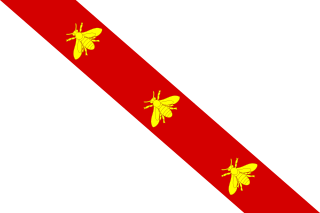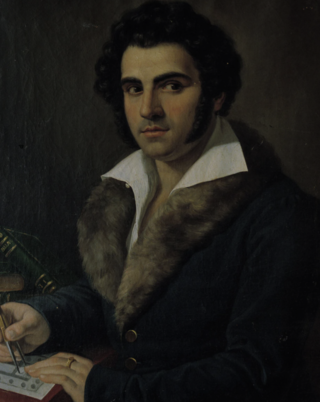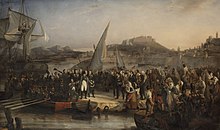
Elba is a Mediterranean island in Tuscany, Italy, 10 km (6.2 mi) from the coastal town of Piombino on the Italian mainland, and the largest island of the Tuscan Archipelago. It is also part of the Arcipelago Toscano National Park, and the third largest island in Italy, after Sicily and Sardinia. It is located in the Tyrrhenian Sea about 50 km (30 mi) east of the French island of Corsica.

Piombino is an Italian town and comune of about 35,000 inhabitants in the province of Livorno (Tuscany). It lies on the border between the Ligurian Sea and the Tyrrhenian Sea, in front of Elba Island and at the northern side of Maremma.
The Treaty of Paris, signed on 30 May 1814, ended the war between France and the Sixth Coalition, part of the Napoleonic Wars, following an armistice signed on 23 April between Charles, Count of Artois, and the allies. The treaty set the borders for France under the House of Bourbon and restored territories to other nations. It is sometimes called the First Peace of Paris, as another one followed in 1815.

The Hundred Days, also known as the War of the Seventh Coalition, marked the period between Napoleon's return from eleven months of exile on the island of Elba to Paris on 20 March 1815 and the second restoration of King Louis XVIII on 8 July 1815. This period saw the War of the Seventh Coalition, and includes the Waterloo Campaign and the Neapolitan War as well as several other minor campaigns. The phrase les Cent Jours was first used by the prefect of Paris, Gaspard, comte de Chabrol, in his speech welcoming the king back to Paris on 8 July.

Emperor of the French was the title of the monarch and supreme ruler of the First and the Second French Empires.

Portoferraio is a town and comune in the province of Livorno, on the edge of the eponymous harbour of the island of Elba. It is the island's largest city. Because of its terrain, many of its buildings are situated on the slopes of a tiny hill bordered on three sides by the sea.

Méditerranée was a department of the First French Empire in present-day Italy. It was named after the Mediterranean Sea. It was formed in 1808, when the Kingdom of Etruria was annexed directly to France. Its capital was Livorno.
Treaty of Fontainebleau may refer to:
Napoleon Bonaparte was a French military and political leader who rose to prominence during the latter stages of the French Revolution and the Napoleonic Wars.

Maria Anna Elisa Bonaparte Baciocchi Levoy, better known as Elisa Bonaparte, was an imperial French princess and sister of Napoleon Bonaparte. She was Princess of Lucca and Piombino (1805-1814), Grand Duchess of Tuscany (1809-1814) and Countess of Compignano by appointment of her brother.

The State of the Presidi was a small territory on the Tuscan coast of Italy that existed between 1557 and 1801. It consisted of remnants of the former Republic of Siena—the five towns of Porto Ercole and Porto Santo Stefano on the promontory of Monte Argentario, as well as Orbetello, Talamone and Ansedonia—and their hinterland, along with the islet of Giannutri and the fortress of Porto Longone on the island of Elba.

The Lordship of Piombino, and after 1594 the Principality of Piombino, was a small state on the Italian peninsula centred on the town of Piombino and including part of the island of Elba. A vassal of the Kingdom of Naples associated with the State of the Presidios and a territory of the Holy Roman Empire formed from the remnants of the Republic of Pisa, it existed from 1399 to 1805, when it was merged into the Principality of Lucca and Piombino. In 1815 it was absorbed into the Grand Duchy of Tuscany.

The Treaty of Fontainebleau was an agreement concluded in Fontainebleau, France, on 11 April 1814 between Napoleon and representatives of Austria, Russia and Prussia. The treaty was signed in Paris on 11 April by the plenipotentiaries of both sides and ratified by Napoleon on 13 April. With this treaty, the allies ended Napoleon's rule as emperor of the French and sent him into exile on Elba.

Count Anatoly Nikolaievich Demidov, 1st Prince of San Donato was a Russian industrialist, diplomat and arts patron of the Demidov family.

The First French Empire, officially the French Republic, then the French Empire after 1809 and also known as Napoleonic France, was the empire ruled by Napoleon Bonaparte, who established French hegemony over much of continental Europe at the beginning of the 19th century. It lasted from 18 May 1804 to 3 May 1814 and again briefly from 20 March 1815 to 7 July 1815, when Napoleon was exiled to St. Helena.

The Principality of Lucca and Piombino was created in July 1805 by Napoleon I for his sister Elisa Bonaparte. It was a state located on the central Italian Peninsula and was a client state of Napoleonic France.

The flag of Elba was used during the period of stay of Napoleon Bonaparte as sovereign of the island of Elba, from 4 May 1814 to 26 February 1815. The flag, donated by Napoleon on his arrival on the island, was hoisted on the highest point of Portoferraio on the day of the landing of the emperor on the island. The original flag is kept in the Napoleon residence, Palazzina dei Mulini in Portoferraio. The meaning of the insignia chosen by the Emperor has long been, and continues to be, a matter of debate among historians.

Napoleon and Me is a 2006 Italian-French-Spanish historical comedy-drama film directed by Paolo Virzì. It is loosely based on the novel N. by Ernesto Ferrero.

Inconstant was a Sylphe-class brig, one of 32, launched in 1811 for the French Navy. In 1815, Napoleon used her to escape from exile on Elba. In the 1820s she took part in the war with Spain and later served on the Brazil station. She also served on the French Guiana station. She was broken up at Brest in December 1843.

Niccolò "Nicola" Matas was an Italian architect and professor. He is best known for being the architect of the 19th century Gothic Revival façade of the Basilica of Santa Croce in Florence, Italy. Matas was a professor at the Academy of Fine Arts, Florence. He is one of the important architects in the history of the city of Florence.
























